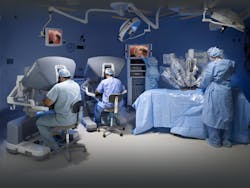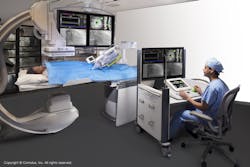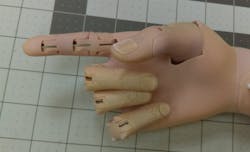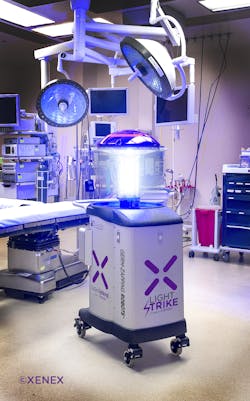6 Ways Robots Will Be the Medical Assistants of Tomorrow
Robotics is an exponentially growing industry and as we know, automation is coming to become our everyday helpers. This is especially true in the medical field. According to research conducted by Tractica, the market for healthcare robots, which includes surgical robots, hospital robots, and rehabilitation robots, will increase in revenue from $1.7 billion in 2016 to $2.8 billion by 2021, at a compound annual growth rate (CAGR) of 9.7%. Tractica predicts that healthcare robot shipments will increase from approximately 3,400 units per year in 2016 to more than 10,500 units per year by 2021. Here are six ways that robots are currently changing the medical field:
BeWell’s Vital Sign Robot Terminal
The Wellpoint System is a robotic point-of-care self-testing kiosk designed to help hospitals in admitting patients. The patient sits at the kiosk and walks the patient through a self-testing protocol. The kiosk can read blood pressure, weight with the embedded seat sensor, pulse oximetry, height measurement, blood analysis, urine analysis, cardiovascular risk analysis, and Accu-Check glucose meter. The vitals are uploaded into the medical record system of the hospital at a rate four times faster than manual input. This gives the medical staff more time to attend the patient’s needs.
The Da Vinci Surgical System
The Da Vinci Surgical System has been aiding surgeons since 2000. It has been used in various procedures including cardiac, thoracic, urologic, hysterectomies, prostatectomies, and gynecological surgeries. The console controls the four robotic arms. The surgeon can sit down at the control console and view the surgery from the integrated camera system. The camera provides a 3D high definition view inside the patient’s body. The jointed wrist design of each of the robot arms provides greater flexibility and reaches allowing for smaller incisions and movement that is more precise. Between the years of 2007 to 2009, the use of Da Vinci Surgical Systems increased by 75%.
Corindus Vascular Robots
Corindus Vascular Robotics is another robot surgical-assist tool use for cardiac procedures. The CorPath GRX is a robotic system used in percutaneous coronary intervention (PCI) procedures such as coronary stenting and ballooning. Manual PCIs were introduced over 40 years and have had a long line of complications including trial and error navigation, deflation of stents when deployed, misalignment of stent position, and eyeball estimation of stent placement. Robot-guided PCI procedures can provide precise point and short placement, precision positioning within 1 mm of accuracy, and stents are held in place when inflated as to not lose position. The main advantage is that it allows the operator to stand outside of the radiation field and may reduce the number of stents used per procedure.
Unlimited Tomorrow Prosthetics
Advanced prosthetics are essential to people recovering from lost limbs and limited mobility. Robotic prosthetics not only replace the lost limbs, giving the patient back their functionality, but also mentally help the patient feel complete. The main problem with these prosthetics is the high cost, which may not be covered by insurance. Here is where Unlimited Tomorrow steps in. Easton LaChappelle founded Unlimited Tomorrow in 2014 when he was 18 years old to help assist people in their everyday lives with realistic 3D-printed robotic arms. LaChappelle has been working with robotics since he was 14 starting with a LEGO-inspired robotic hand, leading to him designing mind-controlled prosthetics and working on NASA’s Robonaut. Recently, LaChappelle used low-cost 3D scanners to digitally map a young girl’s residual limb and opposite full arm to create a realistic robotic replacement limb. Momo’s robotic arm weighs only 1 pound, has individual finger movement, force monitor feedback through haptic sensors, a 3- to 4-day battery life, and is muscle-controlled. The mission of Unlimited Tomorrow “is to empower amputees by an intuitive scalable model to create custom devices from start to finish. We are using the newest technologies such as 3D scans, 3D printing, and machine learning to make the next generation of artificial limbs at the lowest cost possible.” The project, www.TheRoboArm.com, is open-source and accessible to all.
Xenex Disinfecting Robots
Hospital-acquired infections (HAIs) are among the biggest threats to current patients. The same number of people die from HAIs as from AIDS, breast cancer, and auto accidents combined. According to the CDC, 1 out of every 25 patients will contract an HAI and 1 out of every 9 patients will die from the contracted HAI. HAIs cost the healthcare industry about $30 billion annually. Xenex’s LightStrike Germ Zapping Robot is the only pulsed ultraviolet light disinfection system on the robotic market. High-intensity UV light is produced from the xenon flash lamps, which passes through the cell walls of bacteria, viruses, and bacterial spores. The DNA, RNA, and proteins inside the microorganisms become damaged by absorbing the UV light. Damage is caused in three ways: photo-hydration (pulling water molecules into the DNA that prevents transcription), photo-splitting (breaking the backbone of the DNA), and photo-dimerization (improper fusing of DNA bases). The robot has Wi-Fi and cellular connectivity providing live reporting of data including which rooms are clean and has instant monitoring and diagnostic sensors. The robot operates independently, and will detect people entering the room via its triple motion sensor detector and stop the disinfection process for operator safety.
Robot Companions
Humanoid robotic assistants will soon offer patients companionship, in home care, and assist with rehabilitation efforts. According to the American Psychological Association, one of the key factors causing depression is loneliness. Depression affects 300 million people globally and one of the newer solutions is to pair patients with robots. University of Southern California Professor Maja Matarić has been pairing robots with patients since 2014 and has seen incredible results. Her robots helped children with autism copy the motions of socially assistive robots and in 2015, the robots assisted stroke recovery victims with upper extremity exercises. The patients were more responsive to the exercises when promoted and motivated by the robot. The trio of robots seen above—from left to right, NAO, Romeo, and Pepper from Softbank Robotics—are prime examples of what is to come from the world of assistive robots.







